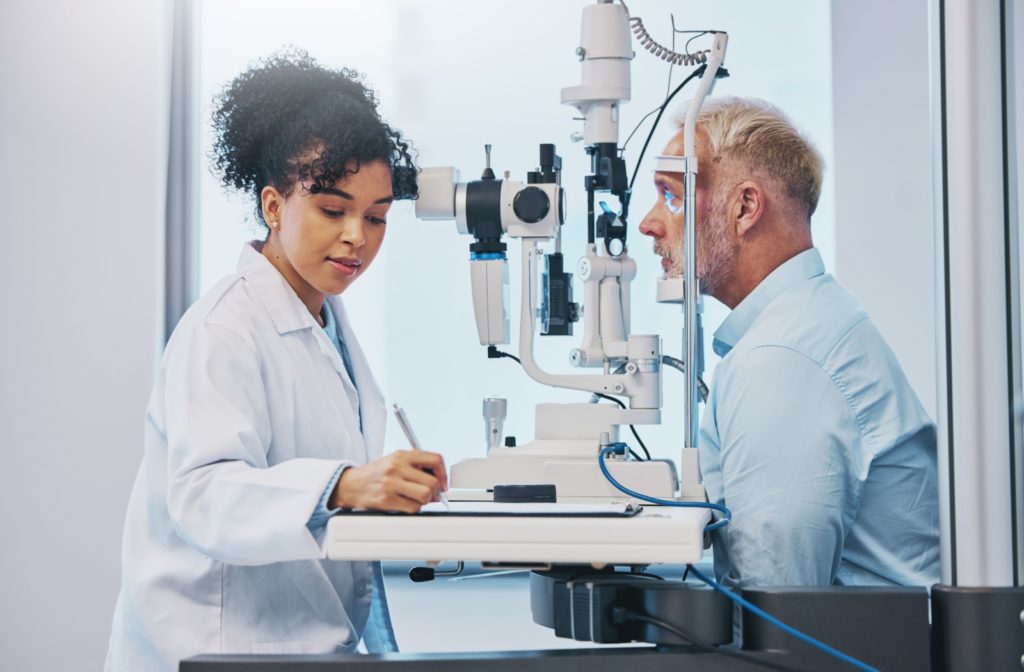Cataracts are one of the most common age-related eye conditions. Fortunately, they’re also easily treatable through cataract surgery—one of the most commonly performed surgeries in the country. However, once you’ve had this surgery, is it a permanent fix? Or will cataracts come back?
After cataract surgery, the condition can’t return. Your now-cloudy lens is removed and replaced with an artificial intraocular lens, giving you clear vision without the risk of future cataracts. If you ever experience unusual vision after cataract surgery, visit your optometrist to receive a proper diagnosis.
What Are Cataracts?
Inside your eye, you have a tiny, clear lens that helps you focus light. It lies just behind your pupil and changes shape as needed to give you clear, sharp vision. It helps to think of this like the lens of a camera.
However, as you age, proteins inside the eye begin to break down, then clump together and form small deposits. This can obstruct light as it enters your eye, leading to blurry vision and hazy spots. These are cataracts.
Common Risk Factors for Cataracts
Cataracts are primarily age-related; at least half of Americans aged 80 and older will experience cataracts or have cataract surgery in their lifetime. However, age isn’t the only factor involved. You’re much more likely to develop cataracts if you:
- Have a family history of cataracts
- Smoke cigarettes
- Have diabetes or other health conditions
- Spend a lot of time in the sun without UV protection
- Have experienced a recent eye injury or other condition
Since cataracts are so common, they’re also highly treatable with the help of an experienced optometrist. So how do you recognize that something’s wrong?
How to Recognize a Cataract
Typically, cataracts develop slowly; this condition can take anywhere between a few months to a few years to fully develop. Recognizing the early signs is key to finding treatment sooner rather than later.
Try to keep an eye out for:
- Blurry spots in your vision
- Poor low-light vision
- Light sensitivity
- Fading colors
- Changes in your glasses or contact prescription
If you notice these signs, don’t ignore them. Cataracts are one of the leading causes of blindness worldwide, and can significantly interfere with your vision. If you experience any of these symptoms, it’s time to seek professional help.
How Are Cataracts Treated?
If you think you’re dealing with a cataract, visit your optometrist for a comprehensive eye exam. They can assess your eyes to determine if cataracts are the cause of your vision issues.
Then, if cataracts are indeed the cause of your symptoms, your optometrist will likely recommend a new set of eyeglasses and contact lenses to counteract any changes in your refractive abilities. As your cataract progresses, your optometrist will work closely with you to manage your symptoms.
However, cataracts are progressive, and there will likely be a point where you should consider surgery. Cataract surgery is a common and effective way to find permanent relief from your symptoms.

What to Expect from Cataract Surgery
If your optometrist believes cataract surgery could be the answer to your vision problems, they’ll refer you to an experienced ophthalmologist in your area. The surgery itself is much simpler than you may think, and typically only takes around an hour or so from start to finish. In fact, it’s the most commonly performed surgery in the country, making it a reliable option for those living with cataracts.
First, you’ll receive dilating eye drops and localized anesthetic. This makes it much easier for your surgeon to perform the surgery while keeping you comfortable. Then:
- Your surgeon will make a small incision in your cornea to access the underlying tissue.
- Ultrasound waves are applied to break up the protein clusters.
- The damaged lens is carefully removed.
- An artificial intraocular lens, or IOL, is installed.
The initial incision is self-adhering and will seal over a short period of time. Then, you’ll have several post-operation appointments with your optometrist so they can monitor your recovery.
What Happens After Cataract Surgery?
Throughout the next few weeks, you may experience some blurry vision, gritty sensations, or itching feelings in the eyes. This is perfectly normal, but avoid scratching or rubbing the affected area. Follow any post-surgery instructions, and you should enjoy a quick and smooth recovery.
Once you’ve recovered, your cataracts shouldn’t return. Your new IOL can’t develop a cataract due to the materials used. However, it is possible to experience cataract-like symptoms, though this is rare. If you experience any sudden changes in your vision, like blurriness or light sensitivity, return to your optometrist for a professional diagnosis.
Get Checked for Cataracts
If you’re experiencing a recent change in your vision, don’t leave the problem unaddressed. Instead, come visit our team at Total Vision Pleasanton to get checked for cataracts. Your vision is precious, and it should always be a top priority in your life, so book an appointment with our team today.



